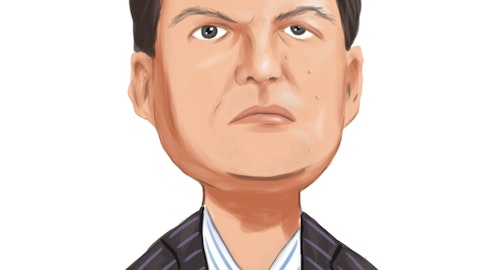Harout Diramerian: Sure. I just want to make sure I understand the 120. I’m guessing that’s the media number that that that kind of would disclose that the consolidated number that also includes the Quixote activity, not just the same-store. So that Quixote activity, as I said previously, is not in the same-store number. So the 14%, sorry, the number that we disclosed for the same-store is without Quixote. So if you factor that in, I think, I mentioned earlier, would be a roughly at a 5% year-over-year increase, which is part of the whole activity for the company. In terms of the drivers year-over-year on the office side. I mean, a big one, obviously, is Square bringing that number down and then WeWork giving back some space at a couple of our buildings. And we also, as I mentioned in my remarks, we received some security deposit and impact in 2023. That’s not reoccurring in 2024. So, impacting the numbers year over year.
Ronald Kamdem: Got it. Okay. And then, so I guess my last one would just be on the, I think, you touched on this earlier, but just on the disposition activity. Any — how are you guys thinking about that? Any other assets in the market? What sort of is the right way for us to think about that? Thanks.
Victor Coleman: Well, as usual, I mean, we’re not going to tell you what we’re disposing of. So, we’re not going to do it until we make the announcement of those assets. But I think I just covered that in the last question. The ones we’re looking at right now are all reverse increase and there’s at least three of them and there may be more.
Ronald Kamdem: Thanks so much.
Victor Coleman: You got it.
Operator: The next question comes from Vikram Malhotra with Mizuho. Please go ahead.
Vikram Malhotra: Good morning. Thanks for answering the question. I just want to go back to the studio side, and again, we’re all trying to just ramp up and understand the kind of the variable non-variable piece of it is — a piece of it. But is the tour activity that you mentioned being up 40%, 45%? Is that a good leading indicator? Like what are the indicators you are monitoring to kind of realize that, hey, the ramp is real or likely and especially the new production as opposed to stuff that just stopped?
Victor Coleman: So, Vikram, I’ll start with that. Listen, the activity is holds, right? I mean, holds on space is the first way, and as a result, they’re reaching out for vacant spaces on the sound stage side. Once they get picked up, then the equipment starts going out the door from that point on. And as I mentioned earlier, anything that was in production is now back in production. So it’s all sort of happening at the same at the same time. Mark?
Mark Lammas: Yeah. Just to add a little bit more color that we are — that’s exactly what we’re watching. As Victor is now, I think, responded to three times or four times at this point. Everything that was. [Audio Gap]
Vikram Malhotra: Hello. Hello.
Operator: Apologies, everyone. It appears that the speakers have disconnected. Please be patient and please wait. Please standby…
Mark Lammas: No. We’re here. We are here. Hello, operator. We’re here.
Vikram Malhotra: Yeah. This is Vikram. I’m sorry. I don’t know where you got cut off, but I don’t think anyone could hear you.
Victor Coleman: Yeah. Sorry, Vikram.
Mark Lammas: Oh! We were just adding a little bit of color in response to your question. We are watching, where TV, television and film show accounts are, and I don’t know if you heard this, but the good news is we are back above where we were at this time last year. But we are still behind or below 2021 and 2022 levels under 21% by say 18% by 25% under 22% by 18% [ph], 2021 was an exceptionally high year because of making up for the pandemic. In any event, as we project out by show count for LA, which is where, the lion’s share of our Quixote business is and our stages are, we do anticipate show count to be at a normalized level at or close to 2021 or 2022 levels sometimes towards the end of second quarter, early third quarter and that’s the sort of the one of the key barometers that we’re keeping an eye on as we think about the recovery in the studio business.
Vikram Malhotra: Got it. Okay. That’s helpful context. Just on the office side, you mentioned the occupancy is under pressure. The first, I think, three quarters when you expect to ramp back up. I’m just wondering, I think, you said, 40% on the expiration, but in the pipeline, or perhaps, these are like leases in LOI or just stuff that sign but not commence. Like what gives you the insight into sort of the down 3 and then up in the fourth quarter? That seems very specific.
Victor Coleman: Well, it is very specific, because that’s the way we model our activity. It’s as granular, Vikram, as you could imagine. I mean, this is inputs from every person on our leasing team assigned to their respective assets and it goes suite by suite on renewal, likelihood of renewal or not renewal on activity on available space. And so when we look at an output on, say, at the end of any particular quarter, it is a very — it’s the — it’s not some high level input and output, it’s a very specific result based on very specific inputs and outputs. And I don’t know how to explain it other than to say the result of all of those inputs is that we see a bit of soft mean in the first half on occupancy with a steady recovery in the third quarter and into the fourth quarter.



